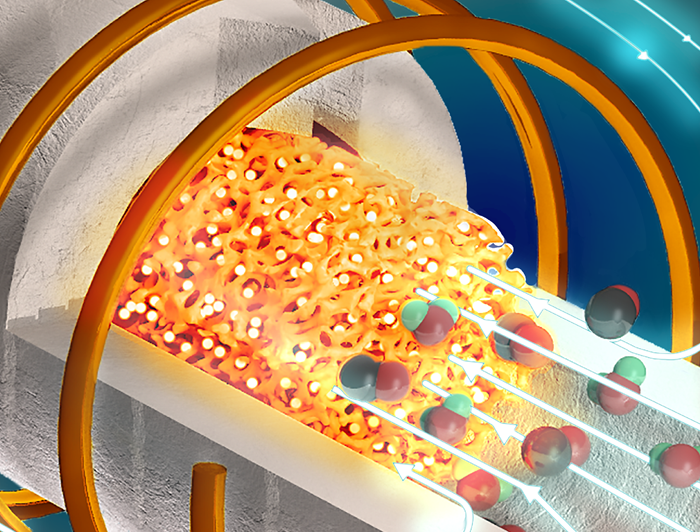Reviewed by Lily Ramsey, LLMAug 21 2024
Researchers at Stanford Engineering have developed and tested a new type of thermochemical reactor that generates large amounts of heat for industrial processes using electricity instead of fossil fuels. The design is more affordable, more efficient, and smaller than current fossil fuel technology. The study was published in the journal Joule.
 This image depicts the inductively heated metamaterial reactor with catalysts filling the ceramic foam baffle. It is producing carbon monoxide and water from the reverse water gas shift reaction. Image Credit: Dolly Mantle.
This image depicts the inductively heated metamaterial reactor with catalysts filling the ceramic foam baffle. It is producing carbon monoxide and water from the reverse water gas shift reaction. Image Credit: Dolly Mantle.
Approximately one-third of the nation's carbon dioxide emissions currently come from industrial activities in the United States, which is even more than the annual emissions from trucks, airlines, and passenger cars put together. Decarbonizing this industry is a difficult but necessary step in reducing its influence on the climate in the future.
We have an electrified and scalable reactor infrastructure for thermochemical processes that features ideal heating and heat-transfer properties. Essentially, we are pushing reactor performance to its physical limits, and we are using green electricity to power it.
Jonathan Fan, Study Senior Author and Associate Professor, School of Electrical Engineering, Stanford University
Heating With Induction
Most conventional thermochemical reactors work like old-fashioned boilers: they burn fossil fuels to heat a fluid, which then circulates through pipes inside the reactor. This method requires extensive infrastructure and is prone to heat loss.
In contrast, the new electrified reactor developed by Stanford engineers uses magnetic induction to generate heat directly within the reactor, similar to how induction stoves work. Instead of heating fluid and transporting it through pipes, this method produces heat internally using electric currents and magnetic fields.
Here’s how it works: When an alternating current flows through a coil wrapped around a steel rod, it creates an oscillating magnetic field. This magnetic field induces a current in the steel rod, and because steel isn’t a perfect conductor, some of this current is converted into heat. This allows the steel to be heated evenly from within rather than from an external source.
To adapt induction heating for industrial applications, the researchers combined materials that are poor electrical conductors with high-frequency alternating currents. This combination enhances the efficiency of heat generation.
For the necessary high-frequency currents, they worked with Juan Rivas-Davila, an Associate Professor of Electrical Engineering. They used his advanced electronics to heat a three-dimensional lattice made from a ceramic material that conducts electricity poorly. The lattice's design includes voids that further reduce electrical conductivity, which, when combined with catalysts, improves heat transfer efficiency.
As a result, this new electrified reactor can produce the required heat more efficiently and in a smaller, more compact design compared to traditional fossil fuel reactors.
You are heating a large surface area structure that is right next to the catalyst, so the heat you are generating gets to the catalyst very quickly to drive the chemical reactions. Plus, it is simplifying everything. You are not transferring heat from somewhere else and losing some along the way, you do not have any pipes going in and out of the reactor – you can fully insulate it. This is ideal from an energy management and cost point of view.
Jonathan Fan, Study Senior Author and Associate Professor, School of Electrical Engineering, Stanford University
Electrified Industry
Matthew Kanan, a Chemistry Professor in the School of Humanities and Sciences and Co-author of the paper, created a new sustainable catalyst that the researchers utilized to fuel the reverse water gas shift process in the reactor. High heat is needed for the reaction to occur, but the result is a valuable gas that may be utilized to make sustainable fuels.
The reactor's efficiency in the proof-of-concept demonstration was above 85%, meaning that nearly all of the electrical energy was transformed into useful heat. Additionally, the reactor displayed perfect circumstances for promoting the chemical reaction: unlike many recent reactor designs, carbon dioxide was transformed into useful gas at the theoretically predicted rate.
As we make these reactors even larger or operate them at even higher temperatures, they just get more efficient. That is the story of electrification – we are not just trying to replace what we have; we are creating even better performance.
Jonathan Fan, Study Senior Author and Associate Professor, School of Electrical Engineering, Stanford University
Fan, Rivas-Davila, Kanan, and others are presently engaged in efforts to increase the size of their recently developed reactor technology and broaden its possible uses. They are modifying the same concepts to create cement and carbon dioxide capture reactors, and they are collaborating with industry partners in the oil and gas sectors to determine what those businesses would require to implement this technology.
They are also performing economic evaluations to determine the nature of system-wide sustainable solutions and how to lower their costs.
Fan said, “Electrification affords us the opportunity to reinvent infrastructure, breaking through existing bottlenecks and shrinking and simplifying these types of reactors, in addition to decarbonizing them. Industrial decarbonization is going to require new, systems-level approaches, and I think we are just getting started.”
Co-authors include visiting scholar Pinak Mohapatra; Postdoctoral Researcher Chenghao Wan; and graduate students Calvin H. Lin, Zhennan Ru, Connor Cremers, Dolly L. Mantle, Kesha Tamakuwala, and Ariana Höfelmann.
The research was supported by the Stanford Doerr School of Sustainability Accelerator, the National Science Foundation, the Gates Millennium Scholarship, and the Stanford Graduate Fellowship.
Journal Reference:
Lin, C. H., et al. (2024) Electrified thermochemical reaction systems with high-frequency metamaterial reactors. Joule. doi.org/10.1016/j.joule.2024.07.017.